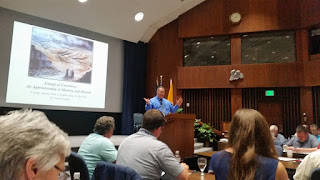FR. ANTHONY RUFF "What does Church Music Have to do With My Life? Music and the New Evangelization"
The Problem
Young people think organized religion is not for good and that rituals of the church are meaningless. Inherited structure is meaningless.
But his students are curious open and searching for meaning. They are often surprised that the rituals of the church can have meaning. It's news to them that liturgy is participation in salvation history.
Why is it a surprise that the rites are saving? Poor catechesis?
What happens in the Eucharistic prayer? EVERYTHING
Christian Symbol and Ritual Bernard Cooke and Gary Macy starts with human experience... Very Rahnerian. He uses it to teach, because students today need that approach.
Five aspects of Ritual:
- Hermeneutic of experience
- Maturation
- Presence
- Service
- Friendship
Rahner Foundations of Christian Faith all experience is open to God
vs. Von Balthaasar Intentions A very Critical Intorduction (Kilby) beauty aesthetic acknowledging the beauty of revelation
Rahnerian starting point is a better approach in the Church today rather than zealots with an attitude that church teaching is good and the world is evil
Book he uses is Patrick T McCormick, A Banqueter's Guide to the All-Night Soup Kitchen of the Kingdom of God. Students don't see any of this as spirituality. No connection between social justice and spirituality. Spirituality, in reality, is an entire world view.
MUSIC
How is it meaningful?
Does it relate to spirituality?
Does it relate to my life?
We need a realistic piety around texts we sing
Do the texts of the songs line up with our longings?
Or, are they epiphenomenological? (Do the texts cause the longings?) Or are the songs overly cut off from the real world? Do we balance our faith and doubt?
We don't want to be pious in a sloppy way. No need for a layer of lace and holy water
Instead, we need to respect artistic ability and musical impulse. Do musicians have to be disciples? Sing to the Lord 39 says yes, but we should expect them to be human and not to be perfect.
The Appropriate use of Tradition
SC 112 we need a Thesaurus Musicae Sacrae
Overly traditional impulse comes from a sense that what we have is not working. It's not all bad...
Idealization of chant and stylistic Euro-centrism ignore the culture people come from.
Some agendas more chant, fewer hymns...
The reform of the reform starts with Musical tradition and points to the liturgy... Is backwards. We should start with liturgy and work toward musical tradition
Alcuin Clark T&T Clark Companion to Liturgy. Critique
nothing positive about congregational singing or participation
Musical traditionalism attempts to make music meaningful. Escapist. Misreading of hermeneutic of continuity
We can indeed have a preferential option for tradition in Vatican II
We need a hybrid hermeneutic for interpreting SC chapter 6.
Theological dynamic,culturally sensitive rite plus a solid musical tradition
Music-Makiing as embodied Spirituality:
Sacred Music divinizes us by humanizing us.
Great tradition of music making in the church as humanizing got subverted In The 18th and 19th century when we first had concerts. "Concert culture"
Before 19th century most music making was without any written page
CONCLUSIONS
We need:
- More comfort with our bodies and voices
- Greater relationality in our ensemble music- making -see Voice Care Network website
- Naturalness in proclamation of texts
- Comfort with rhythm and dance
- Relationality in engagement of assembly - cantor eye contact...
- Affirmation of musical professionalism - Greater musical skills enable us to be more human
Multicultural music we need openness to all culture
 But then I thought about it. Our goal should be to make people want Jesus in the Eucharist as much as they want bacon. Really.
But then I thought about it. Our goal should be to make people want Jesus in the Eucharist as much as they want bacon. Really.






